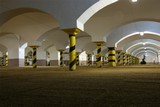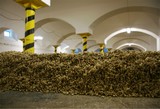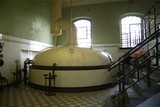How and where we produce our beer (Production of our beer in detail)
MALT HOUSE
 At the malt house, malt is produced from barley. Malting barley is mostly purchased from local farmers. Barley is soaked in soaking vessels for 48 hours with the use of air breaks. The content of humidity of the soaked barley (so called humidity/moisture degree) is about 45%. The soaked barley is squeezed on the threshing-floor and here the process of germination takes place. Every eight hours a process of so called ploughing is performed (originally manual, or later mechanical by a ploughing machine). This ensures that the pile does not intergrow; it regulates the temperature of the pile (up to 25°C) and brings oxygen to the grain.
At the malt house, malt is produced from barley. Malting barley is mostly purchased from local farmers. Barley is soaked in soaking vessels for 48 hours with the use of air breaks. The content of humidity of the soaked barley (so called humidity/moisture degree) is about 45%. The soaked barley is squeezed on the threshing-floor and here the process of germination takes place. Every eight hours a process of so called ploughing is performed (originally manual, or later mechanical by a ploughing machine). This ensures that the pile does not intergrow; it regulates the temperature of the pile (up to 25°C) and brings oxygen to the grain.
 Germination takes 4 to 5 days. Meanwhile, cell walls of the grain are splitted and enzymes are activated. When the grain is properly germinated, the process at the threshing floor is terminated. The pile is picked and it is moved to the kiln, where the process of kilning or drying according to the technological process takes place. The kilning temperature varies between 30°C to 80°C.
Germination takes 4 to 5 days. Meanwhile, cell walls of the grain are splitted and enzymes are activated. When the grain is properly germinated, the process at the threshing floor is terminated. The pile is picked and it is moved to the kiln, where the process of kilning or drying according to the technological process takes place. The kilning temperature varies between 30°C to 80°C.
By virtue of the temperature, melanoid substances, which ensure colour and taste of the malt, appear in the malt. Kilning process takes twice 48 hours and moisture of kilned malt decreases to about 4%. The last procedure is cutting-off the germs (roots). Cleaned malt is put into the attic for 6 weeks to stand.
WORT KETTLE
 Hopped wort is boiled in the wort kettle. Basic ingredients are malt, fresh water and hops. The first procedure in the wort kettle is scrapping. This is done so that glumes of the grain remained in large pieces. These glume pieces are called draff and they serve as a filtration layer in the lauter tun.
Hopped wort is boiled in the wort kettle. Basic ingredients are malt, fresh water and hops. The first procedure in the wort kettle is scrapping. This is done so that glumes of the grain remained in large pieces. These glume pieces are called draff and they serve as a filtration layer in the lauter tun.
The production of hopped wort itself is divided into 5 stages:
1. Pulping
Malt grist is mixed in the lauter tun with water of the temperature of 37°C. At this temperature an enzyme – acidase – which provides proper pH of the mash is activated.
2. Steaming
With the help of hot water we perform steaming, which rises the temperature of mash to 52°C (so called protein-splitting temperature). This temperature activates proteases which split proteins.
3. Mashing
Mashing is a process in which starches are converted into sugars with the help of alfa and beta anylase enzymes. The so called double mashing way is performed. The first mashing –approximately 1/3 of the mash – is released to the mash kettle. It is heated up to 63°C and 72°C when starches start to be converted. This sugaring is tested by a iodine test. After proper sugaring we boil the mash for 30 minutes. The mash is then overdrawn back to the mash tun. The second mashing proceeds in a similar way. The final temperature of the product is 72°C to 75°C after mashing. The whole product is then transferred to the lauter tun and there it rests for 20 minutes. Straining proceeds.
4. Straining
.jpg) For the first two hours the front part of the product flows (about 150 hl). In the next two hours, draff is sweetened by hot water (approximately 140hl). Draff is then thrown into the hopper which means termination of straining.
For the first two hours the front part of the product flows (about 150 hl). In the next two hours, draff is sweetened by hot water (approximately 140hl). Draff is then thrown into the hopper which means termination of straining.
5. Wort Boiling
Malt wort (mash) is boiled in the wort kettle with hops. Wort boiling takes about 2 hours. Granulated hops are added in the amount of 100 to 200g/hl considering the hopped wort concentration. Hops is added in three stages: at the initialization of the wort boiling, after 20 to 30 minutes of boiling, and 10 minutes before the termination of wort boiling.
During wort boiling, bitter substances of hops are leached, hopped wort is scalded by boiling, and water evaporates (7 to 10 %). Part of the proteins that originate in malt is precipitated and we can establish the concentration of the hopped wort.
Finally, hectoliters of boiled hopped wort are measured and saccharimeter measures its concentration. Hopped wort is overdrawn to the whirpool tank, whre the precipitated proteins settle at the bottom as sediments. Hopped wort is then cooled down on the plate cooler to the temperature of 6°C to 7°C (fermentation temperature).
In fermenting cellar, refrigerated hopped wort is drawn to fermentation vessels.
FERMENTING CELLAR
.jpg) Fermented hopped wort is enriched by yeasts (seed yeasts) and the main fermentation starts. The yeasts process sugars and alcohol; carbon dioxide and heat are created. The appearing heat is regulated by cooling, so that the fermentation temperature does not exceed 10°C to 11°C. The main fementation takes approximately 6 to 10 days. In this time, yeasts convert approximately ¾ of the sugar content. The rest of the sugars is converted in the beer-storage cellar during lagering. Yeasts of bottom fermentation are used and after washing they are reused five or six times. New beer from tun is transferred into the beer-storage cellar, where the beer lagers in the lager tanks.
Fermented hopped wort is enriched by yeasts (seed yeasts) and the main fermentation starts. The yeasts process sugars and alcohol; carbon dioxide and heat are created. The appearing heat is regulated by cooling, so that the fermentation temperature does not exceed 10°C to 11°C. The main fementation takes approximately 6 to 10 days. In this time, yeasts convert approximately ¾ of the sugar content. The rest of the sugars is converted in the beer-storage cellar during lagering. Yeasts of bottom fermentation are used and after washing they are reused five or six times. New beer from tun is transferred into the beer-storage cellar, where the beer lagers in the lager tanks.
BEER-STORAGE CELLAR
In the cellar, new beer is filled into the lager tanks. Tanks must be closed so that pressure is created. The pressure is regulated so that it does not exceed 1 atm. Carbon dioxide, which is created under overpressure and low temperature (2°C to 3°C), is satiated in beer and the frothing quality and CO₂ saturation is provided.
One-month lagering is stated for draught beer, two-month lagering for lager beer.
After lagering, filtration follows. We use kieselguhr and plate filtration. Beer treated in this way is further bottled and barreled. While tapping-off, pasteurization is carried out; this means increasing the beer temperature to pasteurizing level (60°C to 70°C). Increased temperature destroys micro-organisms that would participate in the devaluation of beer. This process ensures increased durability of beer. With barreled beer for national market, pasteurization is replaced by microfiltration.
After all the processes the beer can be tasted!
Beer is traditionally tasted with brewer´s greeting:

